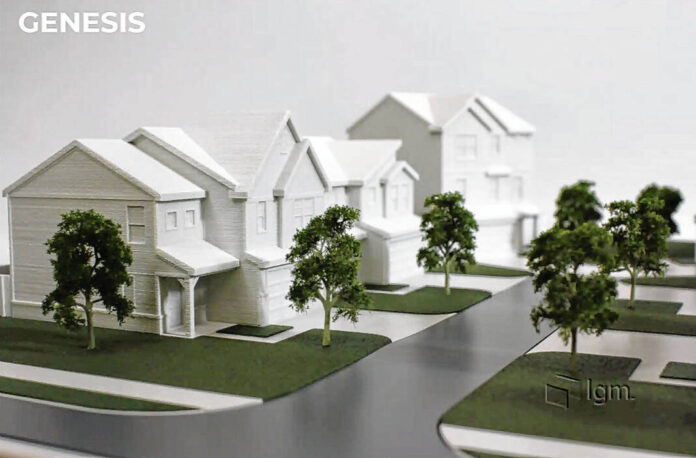
Illustration provided An Artist’s rendition of a Genesis development by Arbor Homes, planned for Columbus’ north side.
Arbor Homes’ plans for a new residential subdivision in north Columbus have been approved by the city.
Columbus City Council voted to pass annexation and rezoning ordinances for the development on second reading and also approved a resolution adopting a fiscal plan for the annexation.
The ordinances annex 98.9 acres into the city of Columbus, including 8.7 acres of right-of-way, and rezone 90.2 acres from Agricultural: Preferred to Residential: Two-Family with commitments for the developer.
The properties for both requests are located on the east and west sides of County Road 200W, about 3,600 feet south of Lowell Road, in Columbus Township. The requests are for a new residential subdivision just south of Arbor’s existing Abbey Place homes.
The developer plans to build a mix of both its typical homes and a new product known as “Genesis,” which is intended to be more affordable for first-time homebuyers. Genesis homes are designed in clusters centered on shared motor courts. Each home would include a two-car garage and fenced yard. The current concept plan proposes 188 lots for Arbor Homes and 92 for Genesis.
“For this particular community, for this extension, we’ve been estimating around 18-24 months from the time of zoning approval until we can start having finished lots,” said Arbor Homes Entitlement Manager Charles Russell, when asked about the timeline of the development. “…The original Abbey Place, we’re still building that community out and completing it. And so that’ll play a factor with this extension as well. Ideally, it’d be beneficial to have Abbey Place starting to be finished up, and then we can have people, the trades, start moving right into the extension to build that.”
He added that new subdivision will be developed in sections, and it will be “some years before it’s fully built out.”
The Columbus Plan Commission voted in February to send the annexation and rezoning requests forward to city council with favorable recommendations. Both requests were approved 9-1, with commission member Barry Kastner voting in opposition.
Kastner had previously expressed concern about adding more residential development to the area, given the lack of services and amenities located nearby, and suggested taking more time to think about how the region should develop.
City services have been a part of discussions surrounding the development. According to the Columbus Fire Department, travel time from Station 1 to the property was 6 minutes and 24 seconds, just shy of the six-and-a-half minute cutoff for acceptable response times — and the test run was made on a Saturday at 8 a.m. in a pickup truck during light traffic.
CFD’s comment was included in the fiscal plan approved by city council, along with various departments’ estimates on what costs, if any, the annexation would pose to them.
Department of Public Works officials said that the development may require them to add one or two more employees and another sanitation route.
“Funding for toters would also need to be increased as 249 homes would require an estimated $30-$40 thousand dollars to purchase trash and recycle toters,” the department added. “If annexation is approved, we will continue to service residents with quality service but it may require some overtime to complete the proposed area.”
“Any program has a certain length of capacity that it can handle,” said city councilman Frank Miller. “And as the city continues to grow, we’re at one of those growth points where we’re at the tipping point, where things are going to have change, budgetarily wise, to cover all of the growth of the city.”
Councilman Tom Dell added that having new taxpayers will help with covering these costs.
In discussing city services, councilwoman Elaine Hilber said that the city should consider adding a bus route to the area, given the distance from amenities and lack of walkability.




